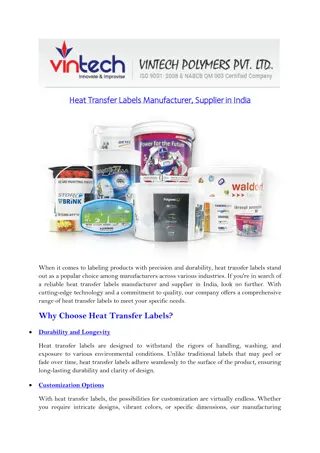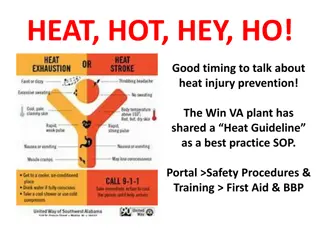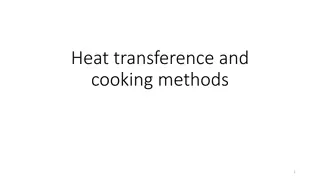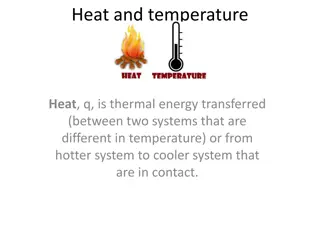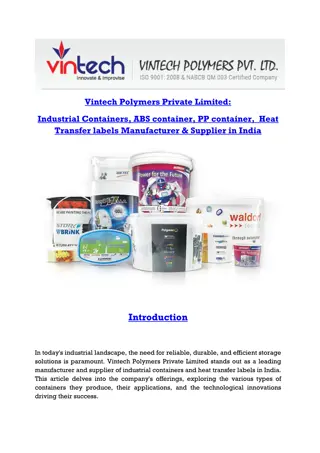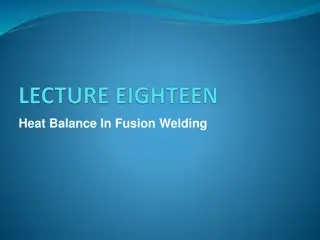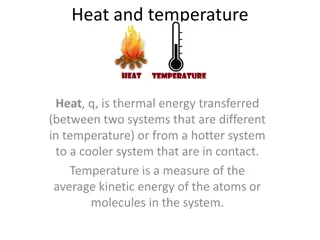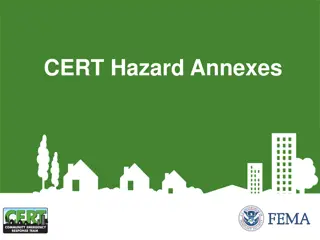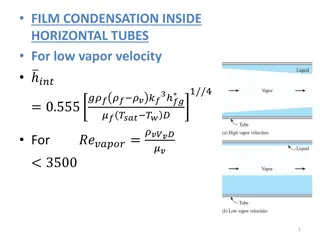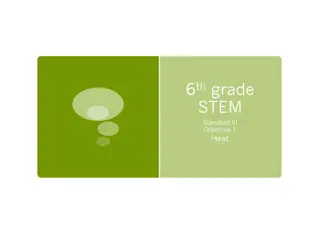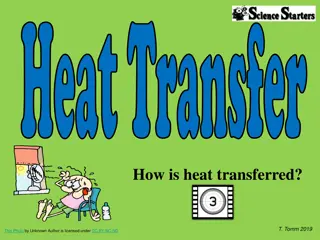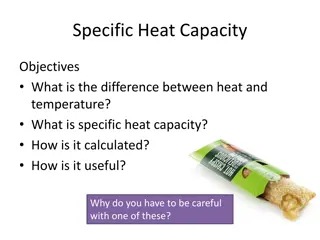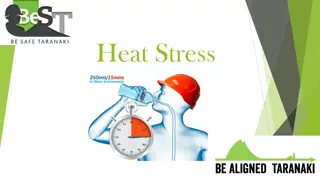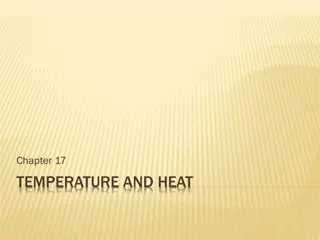HEAT TRANSFER
Explore the various modes of heat transfer, including Fourier's Law of heat conduction, convective heat coefficient, radiant heat coefficient, and more. Discover how temperature is a measure of energy and the difference between heat and temperature. Learn about heat as energy and the specific heat capacities of different substances.
Uploaded on Mar 05, 2025 | 1 Views
Download Presentation

Please find below an Image/Link to download the presentation.
The content on the website is provided AS IS for your information and personal use only. It may not be sold, licensed, or shared on other websites without obtaining consent from the author.If you encounter any issues during the download, it is possible that the publisher has removed the file from their server.
You are allowed to download the files provided on this website for personal or commercial use, subject to the condition that they are used lawfully. All files are the property of their respective owners.
The content on the website is provided AS IS for your information and personal use only. It may not be sold, licensed, or shared on other websites without obtaining consent from the author.
E N D
Presentation Transcript
Content Modes of heat transfer? Fourier Law of heat conduction Convective heat coefficient Radiant heat coefficient Overall heat transfer coefficient Hands-on example
Temperature A measure of energy due to level of heat Freezing point of water is 0 C Boiling point of water is 100 C
What is Heat? Heat is the total internal kinetic energy due to molecular motion in an object Quantity of heat is BTU or Kilo Joule (kJ) One BTU is the amount of heat required to raise 1 lb of water by 1 F One calorie is required to raise 1 g of water by 1 C 1 cal = 4.187 J 1 BTU= 1.055 kJ= 1055 J
Heat Vs Temperature Heat energy depends on mass. Temperature is independent of mass. 2 litres of boiling water has more heat energy than 1 litre of boiling water Temperature is not energy, but a measure of it Heat is energy
Heat is Energy When heat (ie energy) goes into a substance, one of two things can happen: 1. Temperature goes up 2. Change of state
Temperature Goes Up Heat that causes a rise in temperature e.g. heating water before boiling The heat energy is used to increase the kinetic energy of the molecules in the substance This is also known as the sensible heat
Change Of State Heat that brings about a change in potential energy of the molecules (temperature remains constant). Also called the latent heat.
Specific Heat It is the heat required to the temperature of 1 kg (lb) a substance by 1 K (F) Example: water s specific heat is 1 btu/ lb F (4.2 kJ/kg K) air s specific heat is 0.24 btu/ lb F (1.0 kJ/kg K)
Sizing Heating Capacity Quantityof heat required = mass xspecificheat x T Example: What is the heat required to raise air temperature from 15 C to 25 C at a flow rate of 2000 l/s?
Heat Transfer If there is a temperature difference in a system, heat will always move from higher to lower temperatures What is actually flowing?
Heat Transfer Modes There are 3 modes of heat transfer . 1. Conduction 2. Convection 3. Radiation
Conduction Heat transfer through a solid medium via direct contact Expressed by Fourier s Law
Fouriers Law T2 T1 q"= kdT Q dx X k = thermal conductivity(W/ m K) T = temperature (K) q = heat flux (W/m2) Heat flow rate = q x area (W)
Fouriers law at steady state q"= kdT (Fourier Law) dx q"= kTout Tin (Steady State) L q"= Tout Tin L/k Heat transfer rate Q = q"x Area of heat flow q = Tout Tin T2 T1 L/kA R=L/k Unit thermal resistance
Example 1 Temperature of 35 C and 22 C are maintained on opposite sides of a steel floor of 6mm thick. Compute the heat flux through the floor . Thermal conductivity for steel = 50 W/m K
Thermal Conductivity, k (W/m K) Common Metals Copper: 385 Aluminum: 221 Steel: 50 Non-metals Common brick: 0.6 Mineral wool: 0.04 Ceiling board: 0.06 Liquids Water: 0.556 Ammonia: 0.54 Gases Air : 0.024 Water vapor: 0.021
Quiz Suppose a human could live for 2 h unclothed in air at 45 F. How long could she live in water at 45 F?
Electrical- Thermal Analogy q T2 Electrical (Ohm's Law) T1 Current,I =Voltage Potential R=L/kA Resis tance Thermal Heat flux, q =Temperature difference Re sis tance
Composite Wall Using the resistance concept, T 2 T 1 q " = R 1 + R 2 x 1 R 1 = k 1 x 2 R 2 = R1 R2 T2 k 2 T1 Q
Example 2 A wall of a Switchgear room consists the following: 6mm 100mm 25mm TNF panel k = 0.02 W/m K k2 35 C 22 C q2 Q Q Q Steel plate k = 50 W/m K Firebatt k = 0.04 W/m K Determine Q, if the wall is 3m x 4m ?
Convection Energy transfer by fluid motion Two kinds of convection Forced convection: Fluid is forced Natural or free convection: fluid is induced by temperature difference
Convective Heat Transfer Ta y Newton'sLaw of cooling q"=hc(Ts Ta) q air flow Ts (Ts Ta) 1 q"= where: hcis convection coefficient (W/m2C), Tsis surface temperature ( C), Tais surrounding air temperature ( C) h C 1 Rc = hc Rc= unit convective resistance.
Magnitude of Convection Coefficients Arrangement h, W/m2 K Btu/(h.ft2.F) Air, free (indoor) 10-30 1-5 Air, forced (outdoor) 30-300 5-50 Oil, forced 60-1800 10-300 Water, forced 300-6000 50-1000 Steam, condensing 6000-120000 1000-20000
Example 3 The same as Example 2. Consider convection of the exposed surfaces, calculate Q. 6mm 100mm 25mm TNF panel k = 0.02 W/m K k2 35 C 22 C q2 Q Q Q Steel plate k = 50 W/m K Firebatt k = 0.04 W/m K
Radiation Energy emitted by object that is at any temperature above absolute zero Energy is in the form electromagnetic waves No medium needed and travel at speed of light Examp le : Solar radiation Radiator Hot Body
Radiation Important mode of heat at high temperatures, e.g. combustion furnace At room temperature it may just be measurable. Intensity depends on body temperature and surface characteristics
Solar Radiation Solar radiation is the radiation emitted by the sun due to nuclear fusion reaction Solar Constant: The amount of solar energy arriving at the top of the atmosphere perpendicular to the sun s rays. = 1375 W m-2
Solar Radiation Spectrum 99% of solar radiation is between 0.3 to 3 m.
Wiens Law m =2900 m T
The Black Body E = A T4 E =The amount of energy (W ) emitted by an object = Stefan-Boltzmann constant = 5.67 x 10-8W m-2K-4 T = Temperature (K) A= area (m2)
The Grey Body Foran actual body, E = Eb = A(T = emissitivity = 0.8-0.9for common materials = 0.02-0.07 for polished metals 4) where
Net Radiant Heat If a hot object is radiating to a cold surrounding, the radiation loss is q = A (T h4 T c 4)
Quiz How much energy does human body radiate? Body temperature is 37 C Body area is 1.5 m2 = 0.7
Radiant Heat Transfer Unit thermal resistance for radiation is written as q " = h r ( T ) 1 R c = h r Radiation coefficient is a function of temperature, radiation properties and geometrical arrangement of the enclosure and the body in question.
Combined convection and radiant Coefficient The heat transfer is combination of convection and radiation q" = q c + q r q" = (h c + h r)( T ) Com bined therm al resistance, 1 R = h c + h r
Combined Surface Coefficients Some practical values of surface coefficients: (source: ASHRAE Fundamentals 1989) Emissivity, =0.9 Air velocity 3.5 m/s h = 22.7 W/m2 K 7 m/s h = 35 W/m2 K Still air h = 8.5 W/ m2 K
Combined modes Thot Thot Outside R3=1/hhot T3 T3 T2 k2 k1 R2=L1/k1 + L2/K2 T1 T1 Inside R1=1/hcold Tcold T Tcold Resistance in parallel, R= R1 + R2 +R3
Compute Thot R = R1+ R2+ R3 1 1 L1 L2 R3=1/hhot R = + /+ + hcold k1 k2 hhot Thot Tcold T2 q"= R2=L1/k1 + L2/k2 1/hhot+1/hcold+ L1/k1+ L2/k2 q"=T1 Tcold T1 1/hcold T2 Tcold R1=1/hcold q"= 1/hcold+ L1/k1+ L2/k2 Tcold
Overall Heat Transfer Coefficient Heat transfer processes includes conduction, convectionand radiation simultaneously The total conduction heat transfer for a wall or roof is expressed as Q = A x U x T where U is the overall heat transfer coefficient (or U- value) R = R 1 + R 2 + R 3 + ....... 1 = U R
Example Find the overall heat transfer coefficient of a flat roof having the construction shown in the figure.
Solution T1 R1 R2 R3 R4 R5 R6 T2
Solution Resistance Construction Unit resistance (m2 K/ W) R1 Outside air R2 steel R3 Mineral wool R4 Air space R5 Ceiling board R6 Inside air Total R
Solution Overallheat transfer coefficient U =1= 1 = 0.40W/m2K R 2.48
Heat Transfer Loop in a DX System
Heat Exchanger Coil Heat is exchanged between 2 fluids. Q= UA T For cross flow, Q= UA (LMTD)
Heat Exchanger- Mean Temperature Difference Heat Transfer,Q=UxArea xLMTD Q=UxArea xGTD-LTD LnGTD LTD
Heat transfer optimization We have the following relations for heat transfer: Conduction: Q = k A T /d Convection: Radiation: Q = A hr T As a result, when equipment designers want to improve heat transfer rates, they focus on: Increasing the area A, e.g. by using profiled tubes and ribbed surfaces. Increasing T (which is not always controllable). For conduction, increasing k/d. Increase hcby not relying on natural convection, but introducingforced convection. Increase hr, by using black surfaces. Q = A hc T



